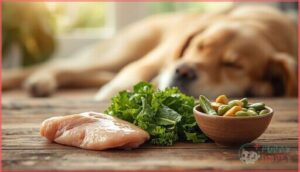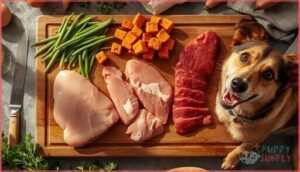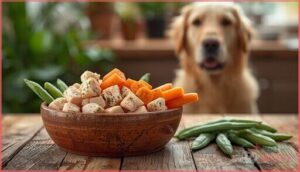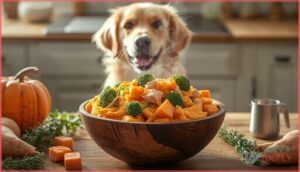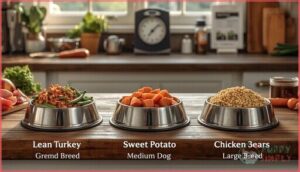This site is supported by our readers. We may earn a commission, at no cost to you, if you purchase through links.
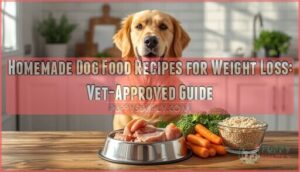
Your dog’s waistline might be the difference between a decade of tail wags and years cut short by preventable disease. Over half of dogs in the United States carry excess weight, and many owners don’t realize their companion has crossed the line from pleasantly plump to medically obese.
Commercial weight-loss formulas promise results, but they often fall short on taste and leave dogs perpetually hungry. Homemade dog food recipes for weight loss give you control over every ingredient, allowing you to craft nutrient-dense meals that satisfy your dog’s appetite while trimming pounds safely.
The right combination of lean proteins, fiber-rich vegetables, and carefully calculated portions can transform your dog’s health—but only if you understand the science behind canine weight management and avoid the common pitfalls that turn well-intentioned home cooking into nutritional disaster.
Table Of Contents
- Key Takeaways
- Signs Your Dog Needs Weight Loss
- Key Nutrients for Weight Loss Recipes
- Calculating Your Dog’s Calorie Needs
- Best Lean Proteins for Homemade Dog Food
- Fiber-Rich Vegetables and Healthy Carbs
- Homemade Dog Food Recipes for Weight Loss
- Safe Preparation and Storage Practices
- Customizing Recipes for Your Dog
- Monitoring Progress and Adjusting Diet
- Common Homemade Diet Mistakes to Avoid
- Frequently Asked Questions (FAQs)
- What can I make for my dog to lose weight?
- What ingredients should be in homemade dog food?
- What vegetable helps dogs lose weight?
- What homemade food can dogs eat everyday?
- How do I safely store homemade dog food recipes?
- Can I use homemade dog food recipes for puppies?
- How do I identify food allergies in my dog?
- Can I add fruits to my dogs homemade food recipes?
- How often should I consult with my veterinarian?
- How long does homemade dog food stay fresh?
- Conclusion
Key Takeaways
- Over half of U.S. dogs carry excess weight, but homemade weight-loss recipes give you control over lean proteins, fiber-rich vegetables, and precise portions that satisfy appetite while trimming pounds safely—though 94% of homemade diets lack proper nutritional balance without veterinary oversight.
- Effective weight loss requires high protein (90-120g per 1,000 calories) to protect muscle, extremely low fat (under 10% dry-matter basis), and 15-20% fiber to trigger satiety hormones and cut voluntary intake by up to 27%, all calculated from your dog’s ideal body weight using RER formulas.
- Top lean proteins include skinless chicken breast (31g protein, 3.6g fat per 100g), cod (0.7g fat), and 90%+ lean ground beef, while fiber sources like green beans, pumpkin, and low-glycemic carbs add volume without excess calories—but recipes must include calcium, vitamin D, B12, and other supplements to meet AAFCO standards.
- Safe implementation demands veterinary consultation before starting, weekly weigh-ins targeting 1-2% loss per week, recalculating calories every 3 months as weight drops, and watching for deficiency signs like dull coat or muscle weakness that signal nutritional gaps.
Signs Your Dog Needs Weight Loss
You mightn’t realize your dog needs to lose weight until specific signs start showing up. Some indicators are physical, like a disappearing waistline, while others affect your dog’s energy and overall health.
Here’s what to watch for and why it matters enough to take action.
Recognizing Overweight in Dogs
You can spot an overweight dog by checking their Body Condition Score. Stand above your pup—if you can’t see a waistline, that’s a red flag. Run your hands along their ribs; Rib Palpation should feel easy, not buried under fat deposits. Watch for behavioral changes too, like reluctance during walks. These signs mean it’s time for canine weight management through better fat content control and weight loss strategies.
Veterinarians use Body Condition Scores to assess a dog’s physical status.
Health Risks of Excess Weight
Excess weight isn’t just cosmetic—it’s a ticking clock. Overweight dogs face a reduced lifespan of up to 2.5 years, plus joint degeneration that leads to arthritis. Insulin resistance raises diabetes risk, while increased heart workload can trigger cardiovascular problems. Even cancer risk climbs in obese dogs.
That’s why dog weight loss through calorie control and a proper dog diet isn’t optional—it’s lifesaving. In fact, pet obesity is the most common preventable disease in North American dogs.
Consulting Your Veterinarian
Before you start cooking, book a nutritional assessment with your vet. They’ll document your dog’s diet history, set realistic weight loss goals, and calculate exact portions based on ideal body weight.
Nutritional guidelines for dogs stress that homemade weight management diets need veterinary oversight to prevent deficiencies. Your vet will also schedule follow-up consultations and recommend any necessary dog supplements, ensuring your pet’s health throughout the journey.
Key Nutrients for Weight Loss Recipes
When you’re putting together homemade dog food for weight loss, getting the nutrients right matters more than simply cutting calories. Your dog needs specific building blocks—protein to protect muscle, fat kept low to trim excess weight, and fiber to keep hunger at bay.
Let’s break down the three essential nutrients that form the foundation of any effective weight loss recipe.
Importance of High Protein
When your dog sheds pounds, you want fat to disappear—not muscle. High-protein dog food becomes your best ally during weight loss, generally providing 90–120 grams of protein per 1,000 calories to safeguard lean tissue.
Research shows this approach delivers three key advantages:
- Muscle maintenance during calorie restriction
- Satiety control that reduces begging behavior
- Metabolic effects including improved triglycerides and reduced inflammation
These protein guidelines support safe, sustainable weight loss in homemade formulations.
Choosing Low-Fat Ingredients
Beyond protein, you’ll need to manage fat carefully—aim for diets containing less than 10% fat on a dry-matter basis. Lean protein sources like skinless chicken, 95% lean beef, and white fish keep fat content around 24–32 grams per 1,000 calories.
Swap fatty cuts for trimmed options, limit oils to fractions of a teaspoon, and choose plain cooked grains over butter-laden starches for balanced lowfat dog food recipes.
Role of Fiber in Satiety
Fiber is your secret weapon against begging eyes and empty bowls. Diets with 15–20% total dietary fiber can cut voluntary calorie intake by 27% compared with low-fiber formulas—dogs feel fuller on less.
Fermentable fibers like beet pulp trigger satiety hormones (GLP-1, PYY), while insoluble types add stool bulk and gastric stretch.
Just watch palatability limits; excessive fiber can backfire on digestive health and nutrient absorption.
Calculating Your Dog’s Calorie Needs
You can’t manage what you don’t measure, and that’s especially true for your dog’s weight loss journey. Determining the right calorie intake requires knowing your dog’s ideal weight, calculating their daily energy needs, and factoring in how much they actually move throughout the day.
Let’s break down each step so you can create a feeding plan that works.
Assessing Ideal Body Weight
Before you can manage weight loss, you need to know where you’re aiming. Visual indicators like a visible waistline and abdominal tuck, combined with palpation methods to feel ribs under a thin fat layer, help establish ideal body weight.
BCS scoring on a 9-point scale—where 4-5 represents ideal—gives you objective benchmarks. These anthropometric proxies guide calorie control and portion size adjustments for effective weight management.
Daily Calorie Requirements
Once you know your dog’s ideal weight, you’ll use the RER calculation—70 × body weight (kg)^0.75—to find baseline daily calories.
For weight loss, aim for roughly 60–80% of maintenance needs, creating the calorie deficit that drives fat reduction.
Recipe energy density matters: track every kilocalorie from meals and treats to maintain calorie control and support steady, safe weight management without guessing.
Adjusting for Activity Level
Activity level isn’t an afterthought—it reshapes your dog’s energy needs by 20–40%, even during weight loss. Activity multipliers of 0.8–1.0 times RER reflect typical reduced activity in weight-loss feeding plans, far below the 1.4–1.5 factor used for active dogs.
Misclassifying a sedentary dog as moderately active can stall progress entirely, so honest assessment drives effective calorie control and metabolic rate management.
Best Lean Proteins for Homemade Dog Food
Choosing the right protein source makes all the difference when you’re trying to help your dog shed pounds safely. Lean proteins protect muscle mass during weight loss while keeping calories in check, but not all meat options are created equal.
Let’s look at the best choices for your homemade weight loss recipes and how to use them effectively.
Chicken, Turkey, and Fish Options
When you’re building a weight loss recipe, lean poultry protein sources and fish deliver high protein with minimal fat—skinless chicken breast packs about 31 g protein and only 3.6 g fat per 100 g cooked, while cod offers ultra-lean nutrition at just 0.7 g fat. Here’s what to know about using these ingredients safely in homemade dog food:
- Ground turkey and turkey breast provide roughly 29 g protein with 2 g fat per 100 g roasted, making them slightly leaner than chicken breast for calorie-restricted recipes.
- Chicken breast remains a staple for recipe customization, but always remove skin and visible fat to keep calories in check and support nutritional completeness.
- Cod and other white fish work beautifully when you need significant fat restriction—their ultra-low calorie density (about 82 kcal per 100 g) lets you offer larger portions without overshooting daily targets.
- Salmon contributes fish oil benefits through omega-3 fatty acids but contains more fat (around 6 g per 100 g), so use smaller portions or pair it with very low-calorie vegetables.
- Cooking safety tips are non-negotiable—always cook poultry and fish thoroughly to eliminate Salmonella and other pathogens found in 80% of raw samples in one study, protecting both your dog and your household.
Lean proteins alone won’t guarantee weight loss or nutritional completeness, so pair these choices with fiber-rich vegetables and work with your vet to balance micronutrients.
Beef and Liver Considerations
Extra-lean ground beef labeled 90% lean or higher cuts fat by two-thirds compared with regular beef—perfect for homemade dog food recipes for weight loss when you need protein density without excess calories.
Beef liver packs micronutrients but requires caution: limit it to roughly 5% of your dog’s intake to avoid liver vitamin A toxicity and copper storage disease risks.
| Ingredient | Key Benefit for Weight Loss |
|---|---|
| 90%+ lean ground beef | High protein, minimal fat content |
| Beef liver (limited) | Micronutrient density without bulk |
| 95/5 lean beef | Ultra-low fat for calorie control |
| Grass-fed sources | Reduced contaminant exposure |
| Small liver portions | Safe liver amounts prevent toxicity |
Safe liver amounts mean about 1 ounce daily for small dogs, up to 2–3 ounces for large breeds—always consult your vet before adding organ meats to weight loss for dogs recipes.
Protein Rotation Strategies
Rotating lean protein sources every 2–6 weeks broadens amino acids coverage and may reduce sensitivity risks while supporting your dog’s microbiome. Novel proteins—like fish after poultry—offer variety without spiking fat.
Practical design tips for protein rotation:
- Maintain similar fat and fiber across recipes
- Introduce new animal protein over 3–7 days
- Choose 3–5 lean protein sources per 12-week cycle
- Keep each recipe AAFCO-compliant independently
Fiber-Rich Vegetables and Healthy Carbs
Vegetables and whole-food carbohydrates play a critical role in weight loss recipes by adding volume and fiber without excessive calories.
Not all produce is safe or equally beneficial for dogs, so choosing the right options matters for both safety and effectiveness.
Here’s what you need to know about selecting fiber-rich vegetables and low-glycemic carbs for your dog’s weight loss plan.
Safe Vegetables for Dogs
When you’re choosing veggies for weight-loss dog food, stick to fiber-rich vegetables like green beans, carrots, broccoli, and zucchini—all deliver bulk without excess calories. Cook vegetables thoroughly to improve digestibility and eliminate antinutritional factors.
Avoid toxic vegetables including onions, garlic, and leeks, which damage red blood cells even in small amounts. Watch for food sensitivities and dietary restrictions, introducing new ingredients gradually to catch any allergen warnings early.
Pumpkin and Sweet Potato Benefits
Pumpkin and sweet potato rank among the most adaptable fiber-rich options for weight loss. Plain canned pumpkin delivers about 26–34 kilocalories per 100 grams—roughly one-third the caloric density of sweet potato—making it ideal when you need volume without excess energy.
Key benefits you’ll see:
- Fiber content: Pumpkin provides 2.4–2.9 grams per 100 grams (60% soluble, 40% insoluble), promoting satiety and normalizing stools.
- Digestive health: Soluble fiber absorbs excess water, often resolving diarrhea within 12–24 hours at 1–4 tablespoons per meal.
- Nutrient contribution: Both offer vitamin A, potassium, and antioxidants that support immune function during calorie restriction.
- Caloric control: Sweet potato (86 kilocalories per 100 grams) requires tighter portioning but contributes twice the protein of pumpkin.
- Recipe safety: Limit pumpkin to 10% of daily intake and avoid pie filling with added sugars that undermine weight loss goals.
Introduce either ingredient gradually and coordinate portions with your veterinarian to maintain nutrient balance.
Low-Glycemic Carbohydrate Choices
Slower-digesting carbohydrates stabilize blood sugar and curb hunger between meals. Studies on sled dogs show grain-free formulas averaged a glycemic index of 41 versus 83 for traditional grains, confirming measurable differences in glucose response. Before adding any carbohydrate sources, arrange a vet consultation to match fiber content and caloric density to your dog’s weight-loss plan.
| Ingredient | Key Benefit |
|---|---|
| Barley & oats | Steady energy release; fosters glycemic control |
| Lentils & chickpeas | Low-carb profile with added protein for satiety |
| Green peas | Moderate fiber; legume benefits without excess starch |
| Sweet potato (limited) | Controlled portions provide vitamin A |
| Brown rice (minimal) | Occasional grain option; higher GI than legumes |
Homemade Dog Food Recipes for Weight Loss
Now that you understand the building blocks of a weight-loss diet for your dog, it’s time to put theory into practice.
The following recipes combine lean proteins, fiber-rich vegetables, and essential nutrients to create meals that promote steady, healthy weight loss. Each recipe is designed to keep your dog satisfied while staying within appropriate calorie limits.
Lean Chicken and Veggie Bowl
You can combine skinless boiled chicken breast with low-calorie veggies like carrots and green beans to create a nutrient-dense foundation for weight loss. Homemade dog food recipes like this lean chicken bowl deliver roughly 165 kilocalories per 100 grams of poultry, supporting portion control while keeping your dog satisfied.
Recipe variations allow you to rotate vegetables seasonally, but supplement needs remain essential—chicken and veggies alone won’t meet AAFCO standards without added vitamins and minerals to help palatability concerns don’t compromise healthy dog food recipes.
Fish and Greens Weight Loss Stew
White-fleshed fish like cod delivers lean protein—around 280 to 330 kilocalories per 100 grams in weight-management formulations—while dark leafy greens such as spinach provide fiber that can cut total calorie intake by up to 30 percent when they replace a fifth of the ration.
- Fish Protein Quality: Cod offers 22–28% crude protein on an as-fed basis, preserving muscle during restriction.
- Greens Fiber Content: Fiber-rich spinach boosts satiety and digestive regularity.
- Veterinary Formulation: Only 6% of homemade recipes meet nutritional standards without professional guidance.
Turkey and Pumpkin Protein Mash
You’ll find the secret to sustainable weight loss in homemade dog food recipes for dieting dogs that pair high protein with filling fiber. This turkey and pumpkin protein mash starts with ground turkey—delivering roughly 203 kilocalories and 8 grams of protein per 100 grams—and adds pumpkin puree to stretch volume without packing on calories.
| Recipe Element | Nutritional Contribution | Weight-Loss Benefit |
|---|---|---|
| Lean ground turkey | 22–24 g protein per 100 g cooked | Protects muscle mass during calorie restriction |
| Pumpkin puree | 2.9–3.6 g fiber, ~34–45 kcal per 100 g | Boosts satiety, reduces voluntary intake up to 20% |
| Sweet potato | Moderate-carb vegetable base | Provides steady energy without excess fat |
| Broccoli | Low-energy micronutrient source | Adds volume and essential vitamins |
| Required supplements | Calcium, phosphorus, B12, choline | Corrects deficiencies in unsupplemented recipes |
A typical batch uses 255 grams roasted turkey breast, 85 grams lean ground turkey, 300 grams sweet potato, 120 grams pumpkin puree, and 80 grams broccoli—totaling around 1,000 to 1,200 kilocalories before supplement additions. This recipe’s macronutrient profile targets 60–70 percent of calories from lean protein, keeping caloric density near 200 to 250 kilocalories per 100 grams—well below maintenance formulas.
Fiber benefits from pumpkin come into sharp focus here: adding just 1 to 4 tablespoons per meal can dial down your dog’s voluntary food intake when woven into a controlled-calorie plan. Because pumpkin is roughly 90 percent water, it stretches meal volume without tipping the calorie scale, lowering overall energy density by 10 to 20 percent compared with starchy substitutes.
Supplement needs are non-negotiable. Without a complete canine multivitamin-mineral blend, fish oil, and iodized salt, this recipe falls short on calcium (AAFCO minimum: 1.25 g per 1,000 kcal), phosphorus, vitamin D, B12, and choline—deficiencies that emerge after weeks of exclusive feeding. Practical parameters call for feeding approximately 1.0 to 1.2 times your dog’s resting energy requirement, split into two daily meals, and rechecking body condition every 2 to 4 weeks to fine-tune portions and preserve nutrient adequacy throughout weight loss.
Safe Preparation and Storage Practices
Making nutritious meals is only half the equation—you also need to handle and store them properly to keep your dog safe. Poor food safety practices can lead to bacterial contamination, nutrient loss, and wasted effort.
Let’s walk through the essential steps for preparing, cooling, portioning, and storing homemade dog food the right way.
Cooking Methods to Preserve Nutrients
How you cook your homemade dog food directly impacts its nutritional value. Gentle steaming tops the list for nutrient retention, preserving heat-sensitive vitamins better than boiling, which causes nutrient leaching into the water.
Dry-heat methods like baking work well but require careful cooking time to prevent omega-3 breakdown.
Raw feeding maximizes enzyme preservation, though dog food safety demands professional guidance to guarantee complete nutrition.
Cooling, Portioning, and Storing Meals
Once you’ve cooked your homemade dog food, rapid cooling matters—bacteria thrive between 40°F and 140°F. Cool meals quickly, then refrigerate at 40°F or below within visible steam reduction. Use refrigerated portions within 3–4 days.
For freezing guidelines, divide batches into single-meal containers and freeze immediately.
Portion control through pre-measured servings prevents overeating, a proven driver of excess intake in dogs.
Preventing Bacterial Contamination
Proper kitchen disinfection and hand hygiene protect both your family and your dog. Wash hands with soap for 20 seconds before and after handling raw ingredients—studies link inadequate handwashing to human Salmonella infections from pet food.
Disinfect cutting boards, bowls, and countertops immediately after use with a 10% bleach solution, since bacteria persist on food-contact surfaces and increase household infection risk.
Customizing Recipes for Your Dog
Your dog’s needs aren’t the same as the neighbor’s retriever or your friend’s terrier. Every dog has unique sensitivities, size requirements, and nutritional gaps that demand thoughtful adjustments to any recipe.
Let’s walk through how to modify homemade weight loss meals so they work safely and effectively for your specific dog.
Ingredient Substitutions for Allergies
When your dog reacts to common proteins like beef or chicken, novel proteins—such as venison, duck, or insect-based options—offer fresh alternatives with minimal allergen exposure. Hydrolyzed proteins break down into smaller peptides, making them ideal for sensitive dogs.
Swap wheat for grain alternatives like sweet potato or tapioca. Adding omega-3s from fish oil promotes skin health during allergen avoidance, helping you create truly hypoallergenic diets fitted to your dog’s needs.
Adjusting Portions for Size and Age
Once you’ve nailed the right ingredients, calorie counting for dogs becomes your next step. Portion sizes shift dramatically with life stage and body size:
- Puppies need 2–3× more calories per pound than adults, but taper intake as they near maturity.
- Senior dogs require 20–25% fewer calories due to slower metabolism.
- Activity levels can double energy needs—sedentary dogs eat half what working breeds consume.
- Breed differences matter: small dogs burn energy faster per pound than giants.
- Calorie density of your recipe dictates serving size; high-fiber blends allow larger bowls at the same calorie target.
Adjust every few weeks based on weigh-ins.
Adding Supplements Safely
With portions dialed in, supplements fill nutritional gaps in canine nutrition—but dosing matters. You’ll need calcium at 800–1,000 mg per pound of food (boneless recipes) to hit that 1.2:1 mineral ratio. Omega-3 dosage runs 20–55 mg EPA+DHA per pound of your dog’s weight.
Multivitamin needs cover trace minerals, yet vitamin D safety demands caution—1 mg can poison a 22-pound dog.
Joint supplementation? Start 15 mg glucosamine per kilogram. Always confirm dog vitamin and mineral supplements with your vet.
Monitoring Progress and Adjusting Diet
You can’t just make homemade dog food and hope for the best—you need to watch how your dog responds and adjust as you go. Weight loss isn’t a straight line, and what works in month one might need tweaking by month three.
Let’s look at how to track progress, when to modify recipes, and what warning signs mean your dog isn’t getting what they need.
Tracking Weight Loss Results
You can’t manage what you don’t measure—that’s the foundation of pet weight management. Weigh your dog every 1 to 2 weeks initially, then monthly once progress stabilizes. Target 1-2% weekly weight loss for safe, sustainable results. Monthly BCS evaluation reveals subtle changes that scales might miss.
- Track chest and abdominal girth alongside body weight for complete progress assessment
- Use food diaries for 3-5 days to fine-tune calorie control and adjust portions
- Photographic evidence documents body composition shifts your eyes may overlook
Studies show 96.8% of dogs in structured dog weight management programs achieve measurable results. These monitoring tools transform guesswork into data-driven dog weight loss strategies that work.
Modifying Recipes Over Time
As your dog sheds pounds, their calorie needs shrink—veterinary protocols recommend recalculating at 3-month intervals using the new step-start weight. When a plateau response becomes necessary, trim daily calories by 5-10% and schedule a recheck within 4-6 weeks.
Recipe change should unfold over 1-3 weeks to prevent digestive upset.
Long-term safety demands periodic nutritionist review, since dog weight management success hinges on calorie adjustments that preserve muscle while controlling portions through careful calorie counting and strategic dog food ingredient substitutions.
Recognizing Signs of Nutritional Deficiency
Even well-planned weight loss dog food recipes can miss the mark. Nutritional deficiencies reveal themselves through visible signs you shouldn’t ignore:
- Coat Abnormalities: Dull, flaky, or thinning fur signals omega-3 or zinc gaps
- Muscle Weakness: Stiffness or reluctance to rise suggests vitamin D or calcium shortfalls
- Anemia Signs: Pale gums and fatigue point to iron or B12 deficits
- Digestive Issues: Chronic diarrhea may indicate cobalamin deficiency
- Neurological Symptoms: Seizures or behavioral changes warrant immediate veterinary assessment
Vitamin supplements can’t replace balanced dog health monitoring.
Common Homemade Diet Mistakes to Avoid
Even the best intentions can lead to nutritional pitfalls when you’re making dog food at home. Small missteps in ingredient choices, portion sizes, or recipe balance can undermine your dog’s weight loss progress or create new health problems.
Let’s look at the most common mistakes so you can avoid them from the start.
Unbalanced Macronutrients
Getting the macronutrient mix right in homemade dog food for weight loss isn’t as simple as cutting calories. Studies reveal that 94% of homemade diets lack nutritional balance, with calcium imbalance, vitamin deficiencies, and protein excess topping the list. Mineral shortages and metabolic disruption can derail your dog’s health faster than you’d expect.
Most homemade dog diets fail nutritional balance—94% show calcium imbalances, vitamin gaps, or protein excess that sabotage weight loss
| Common Deficiency | Health Consequence |
|---|---|
| Calcium imbalance | Brittle bones, kidney issues |
| Vitamin D shortage | Muscle weakness |
| Zinc deficiency | Poor skin, immune problems |
| Excess protein | Metabolic strain |
| Low carbohydrates | Energy disruption |
You might think more protein automatically means better weight loss. That’s a dangerous misconception. While protein protects muscle mass, excess amounts stress your dog’s kidneys and liver without improving fat loss. Meanwhile, the inverse calcium-to-phosphorus ratio in many recipes—sometimes 1:10 instead of the ideal 1:1—creates “rubber jaw” and skeletal problems.
Carbohydrate content matters too. Too little disrupts gut health and nutrient absorption. Fat content needs precision—not elimination. Your dog requires fat-soluble vitamins that only absorb with dietary fat present.
The real challenge? Substituting ingredients without professional guidance throws nutritional balance completely off track. Swapping oils or proteins might seem harmless, but it drastically alters the vitamin and mineral profile. That’s why consulting a veterinary nutritionist before starting homemade dog food isn’t optional—it’s essential for safe, effective weight loss.
Unsafe Ingredients and Toxic Foods
Your homemade dog food safety hinges on recognizing toxic foods that can kill. Chocolate toxicity and xylitol dangers top the list—even tiny amounts trigger crisis. Grapes/raisins cause kidney failure, while allium vegetables (onions, garlic) destroy red blood cells. Caffeine risks mirror chocolate’s effects.
Food allergies complicate matters further, so dog food allergen warnings matter. Homemade dog food safety considerations demand you completely eliminate these ingredients—no exceptions, no guesswork.
Overfeeding or Underfeeding
Calorie restriction can backfire if you’re too aggressive—studies show dogs need 50% to 82% of maintenance calories for safe weight loss, not arbitrary cuts. Yet 94% of homemade diets fall short on essential nutrients.
Owner perception is often off; 81% misjudge their dog’s body condition. Balanced diets demand precision: dog food portion control, calorie counting for dogs, and exact serving size prevent both overfeeding and dangerous nutrient deficiencies.
Frequently Asked Questions (FAQs)
What can I make for my dog to lose weight?
You can prepare lean protein bowls combining chicken breast or turkey with fiber-rich vegetables like green beans and pumpkin. These bowls are designed to deliver high-protein, low-calorie satisfaction while supporting gradual, veterinary-approved weight management through precise portion control.
What ingredients should be in homemade dog food?
You’ll need lean proteins like chicken, turkey, or fish alongside fiber-rich vegetables such as carrots and pumpkin.
Healthy fats from fish oil, plus vitamins and minerals, round out a complete nutrient boost.
What vegetable helps dogs lose weight?
Green beans stand out as the top vegetable for weight loss dog meal preparation. Their low-calorie, high-fiber profile makes them ideal for calorie restriction programs, helping dogs feel full while supporting healthy weight management.
What homemade food can dogs eat everyday?
Dogs can eat everyday homemade meals combining lean proteins like chicken or turkey (about 40%), safe vegetables such as carrots and green beans (50%), and grains like oats (10%)—but only when recipes meet AAFCO standards with professional formulation.
How do I safely store homemade dog food recipes?
Store cooked portions in airtight containers in your refrigerator (below 40°F) for up to five days, or freeze them for three months.
Always label with dates, thaw slowly in the fridge, and reheat gently before serving.
Can I use homemade dog food recipes for puppies?
Weight-loss recipes aren’t designed for puppies—like shoes made for adults, they don’t fit. Growing dogs need AAFCO-approved growth diets with higher protein, calcium, and energy, guided by vet oversight to meet puppy nutrition demands.
How do I identify food allergies in my dog?
Watch for nonseasonal itching around paws, ears, and belly, plus recurring ear infections or digestive upset.
An elimination diet using novel proteins remains the best method for diagnosing food sensitivities in dogs.
Can I add fruits to my dogs homemade food recipes?
Yes, but sparingly—fresh ingredients like apples and blueberries offer fiber benefits and dog nutrition support, yet their sugar content demands careful portion sizes.
Avoid toxic fruits like grapes entirely to maintain nutritional balance and dog health.
How often should I consult with my veterinarian?
Schedule an initial diet reassessment within one to two weeks, then weigh your dog biannually.
Breed-specific needs and life stage impacts demand closer monitoring—senior dogs require wellness evaluations twice yearly to catch deficiency risks early.
How long does homemade dog food stay fresh?
Think of homemade dog food like a meal you’d prepare for yourself—refrigeration keeps it fresh for three to five days, while freezing extends safety to three months when stored properly in airtight containers.
Conclusion
Your dog’s transformation from soft around the middle to lean and energetic won’t happen overnight, but homemade dog food recipes for weight loss give you the precision tools to make it happen safely.
Each measured portion, each carefully selected ingredient, brings your companion closer to the vitality they deserve.
Track progress diligently, consult your veterinarian regularly, and remember: sustainable weight loss protects your dog’s future, one balanced meal at a time.
- https://vetmed.tamu.edu/news/press-releases/dog-obesity-linked-to-breed-environment-owner-choices/
- https://www.dogster.com/statistics/pet-obesity-statistics-trends
- https://www.sciencedirect.com/science/article/pii/S0167587724002848
- https://stories.tamu.edu/news/2025/11/21/most-homemade-dog-diets-lack-nutrients-texas-am-study-finds/
- https://www.ucdavis.edu/news/homemade-dog-food-recipes-can-be-risky-business-study-finds


